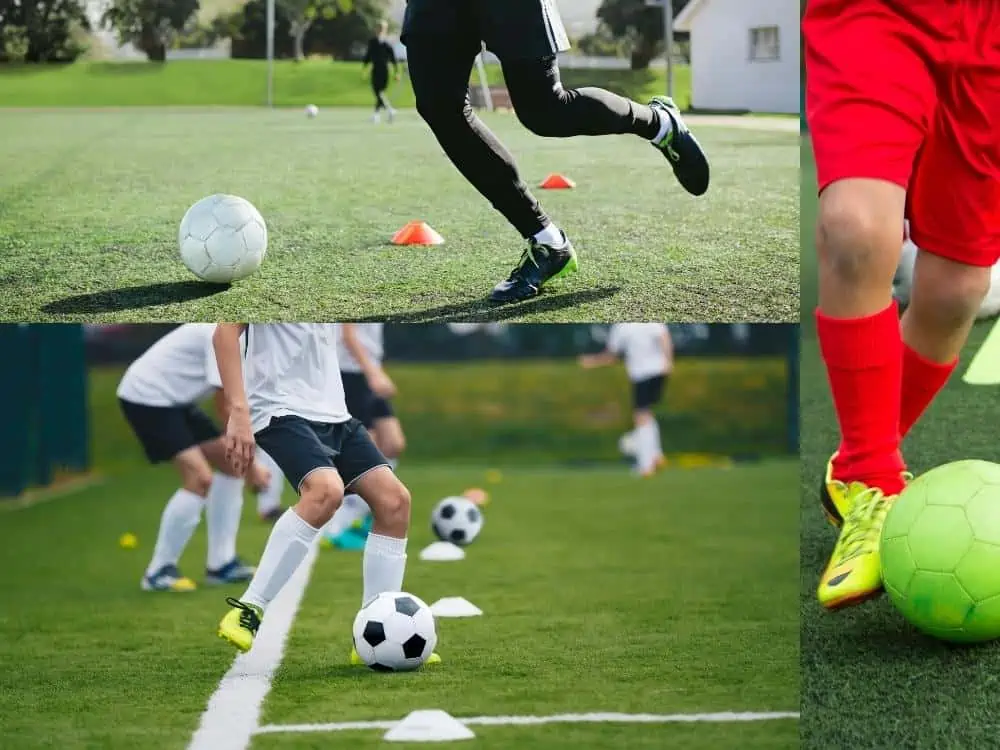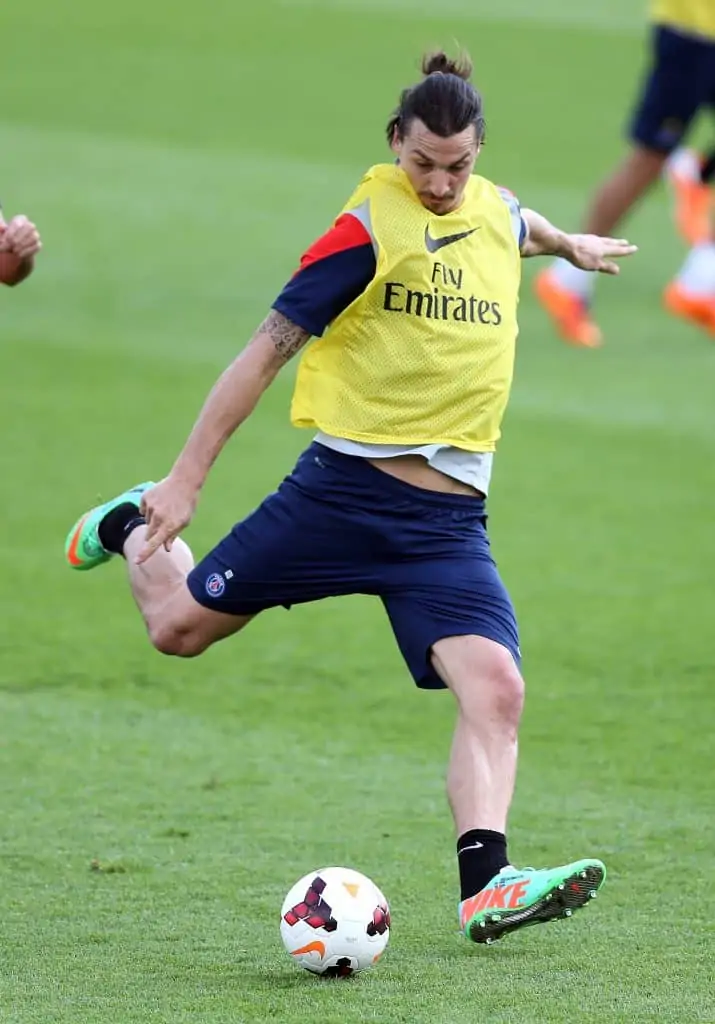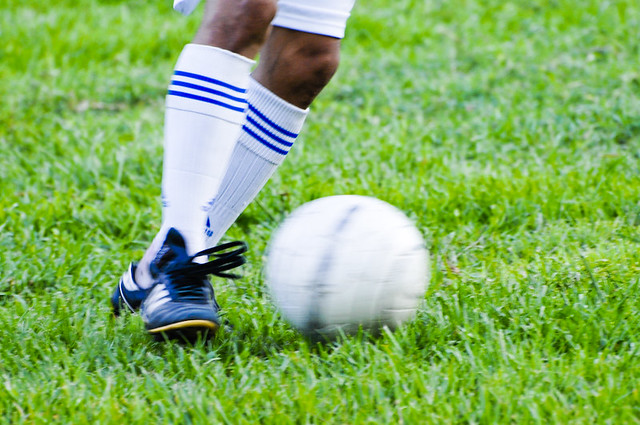Share the post "Beginner Soccer Skills (Steps + Techniques)"
There are so many skills in a game of soccer, so we will take an overview of the most important soccer skills for beginners. Some of the key beginner skills are passing, tackling, and shooting.
We will go through each of the beginner skills required and the techniques needed. Here’s an overview;
- Passing steps and techniques
- Shooting steps and techniques
- Control steps and techniques
- Tackling steps and techniques
- Heading steps and techniques
Each skill is laid out in simple and clear instructions for you to get a good understanding. Let’s get started with the first beginner soccer skill, the core requirements.

- Soccer's 5 Basic Skills for Beginners
- How to Improve Passing Accuracy in Soccer
- How to Pass a Soccer Ball Step by Step
- Soccer Drills for Shooting and Finishing
- How to shoot a soccer ball step by step
- Soccer Ball Control Drills for Beginners
- How to Control a Soccer Ball Step by Step
- Soccer Tackling Drills for Beginners
- How to Tackle a Soccer Ball Step by Step (standing)
- Soccer Tackling Drills for Beginners (sliding)
- How to Slide Tackle a Soccer Ball Step by Step
- Soccer Ball Heading for Beginners
- How to Head a Soccer Ball Step by Step
Soccer’s 5 Basic Skills for Beginners
At its core, soccer revolves around 5 main skills:
- Shooting
- Passing
- Tackling
- Ball Control
- Defending
For the beginner, improving a particular skill or technique should be the focus of training sessions. Building strong fundamentals is the key to becoming a good well-rounded player.
There are many other important things to concentrate on in the sport such as tactics and game plans. However, working on these areas is coach-specific and should be tackled by more advanced players.

How to Improve Passing Accuracy in Soccer
Passing with accuracy can be done with a standard pass is played with the inside of the foot, while a more powerful shot might be struck with the ‘laces’ or the front of the foot.
Here’s a look at the basic passing and shooting techniques. The textbook passing technique used for short to mid-distance passes involves using the inside of the passing foot.

How to Pass a Soccer Ball Step by Step
- Take a short step and plant your standing leg to the side of the ball so that it doesn’t obstruct the kicking leg or the path of the pass. It’s generally good practice to point your standing foot in the direction that you are passing.
- Swing back your kicking leg just enough to generate the necessary power to pass.
- As you swing your leg forward toward the ball, open out your hip, knee, and foot so that the inside of the foot is now going to be the point of contact with the ball.
- Lock the ankle of your kicking leg to ensure stability in the strike.
- Connect with the center of the back of the ball and follow through.
- The pass should be firm but not too powerful.

Soccer Drills for Shooting and Finishing
From close range, it can be very effective to use a passing technique when shooting. It’s the most accurate and controlled way to strike a ball and so when power is not needed, try passing the ball into the net.
For when you do need an extra bit of ‘zip’ on your pass, here’s the classic shooting technique: with the front of the foot.

How to shoot a soccer ball step by step
- Take a few steps back or place the ball a few feet in front of you. A shot requires more power than a pass so the run-up is necessary. Some players like to stand further away than others. Try a few distances to see what suits you best.
- When approaching the ball to shoot, it’s best to take short quick steps. This helps the legs to prepare for the explosive shooting action.
- Plant your standing leg alongside the ball, cocking back your kicking leg.
- Lock the ankle of the kicking leg to make it stable.
- Strike the ball hard with the front of your foot and follow through. Don’t focus too much on power, to the point that the technique or connection with the ball suffers. A balance of technique and power will ensure the best strike.
- Stand upright or lean slightly forward when shooting. Do not lean back or the ball is likely to fly high, wide, and not very handsome.

Soccer Ball Control Drills for Beginners
In a soccer match, one can receive the ball from any direction or height and at various power levels. A player may be forced to use their head, chest, thighs, knees, or feet to control a ball.
Some of these more unorthodox techniques are useful but tricky. For beginners, it’s most important to be able to receive a pass comfortably, with a good touch and control.
Today’s game is possession focused with a huge emphasis being put on passing and ball retention.
It’s crucial for players in all positions to be able to receive the ball in tight areas and be comfortable controlling it under pressure.

How to Control a Soccer Ball Step by Step
- Different scenarios require different body positions. For example:
- In a defensive position, with players closing you down and running towards you, you will want to stand squarely allowing you to take a touch on either side of your opponent to move or pass away.
- In a midfield position, it’s important to be able to turn into space to progress upfield. In this scenario, open up your body upon receiving the ball. Turn out your hips and control the ball using the inside of your foot. This opens up the field and gives you more space, time, and options to make your next move.
- In an advanced attacking position with your back to goal, you should have a low center of gravity, leaning into the defender and shielding the ball from them.
- In all positions, it’s important to “check your shoulder” before receiving. This means looking around to identify the positions of your opponents.
- Use the inside of your foot to control the ball. This is a large, flat part of the foot and so it can absorb the power quite well, killing the ball’s momentum. Over time it’s important to be able to use different parts of the foot to receive a pass, but for beginners, using the inside of both feet should be the area of focus.
- The standing leg should be positioned for balance, defensive shielding, and to set up the next move or pass.

Soccer Tackling Drills for Beginners
Unlike shooting, passing, and dribbling, the art of defending is not so subtle. Tackling is the most important skill to learn for a beginner defender.
There are two main types of tackles: a standing tackle, and a sliding tackle. As a rule of thumb, defenders should try to stay on their feet.
A sliding tackle should only be attempted if absolutely necessary to become one of the best tacklers.

When an opponent is in front of you, trying to dribble or move past you, it’s best practice to position your body in such a way that encourages the attacker to run into space away from your goal.
Slowly close the distance on the attacker, jockeying them away from the goal until a suitable moment comes for you to dispossess your opponent.
It’s generally advised to use your foot closest to the ball to do this.
How to Tackle a Soccer Ball Step by Step (standing)
- Wait for the right moment
- Be 80% sure you will win the tackle
- When the attacker loses control of the ball, strike!
- To poke away, stretch your closest foot towards the ball and use your toe
- To take possession to get your body in between the attacker and the ball
- Crouch slightly with a wide stance to be firm
- Dribble the ball away or pass to a teammate
If you are running alongside an opponent you can either tackle or block the ball by stepping across the attacker, or you can move between the attacker and the ball.
Be careful not to foul your opponent in this instance.

Tackling from behind is the most difficult standing tackle technique. In many situations, a tackle from behind will result in a foul on the attacker.
To avoid this, the defender should move to the side of their opponent and step across, touching or intercepting the ball away from them.
This should only be attempted if the defender is confident that they’ll win possession.
If this tackle attempt fails, the defender will be caught wrong-sided, putting the attacker in an advantageous position.
Soccer Tackling Drills for Beginners (sliding)
A sliding tackle, although impressive to watch and enjoyable to do, should be regarded as a last-ditch attempt to win the ball.
Once you commit to a sliding tackle, there’s no turning back so it’s important to be successful in your attempt.
How to Slide Tackle a Soccer Ball Step by Step
- When the opportunity arises to commit to the tackle, slide across your opponent. Ensure that contact is made with the ball before the player, or else it will be a foul
- Tuck your non-tackling leg behind you as you go to the ground and slide for the ball
- Lock the ankle of your tackling leg for stability
- Use the tackling leg to hook or push the ball away from your opponent
Whentackling, always keep the studs (cleat spikes) pointed downward.
Soccer Ball Heading for Beginners
Heading the ball is an important skill for attacking and defending. Whether clearing a cross or having a scoring attempt, a player must have the right heading technique in their locker.
Timing is the most important aspect of heading. You must judge the flight of the ball in order to be in the right position and to time the header.
How to Head a Soccer Ball Step by Step
- When a high ball is incoming, get into position
- When jumping, narrow the gap between legs – if unchallenged have a firm leg stance
- Keep your eyes on the ball and direct it using your forehead. This can be difficult at first but becomes a lot easier with practice.
- To defend, head from underneath – to shoot head from over the ball to direct to the ground
- Avoid heading with the top of the head as it’s very hard to judge and can cause injury
- If jumping, try to perform the header at the highest point of your jump.
Once you’ve got a good understanding of what we’ve covered, it’s now time to carry out some of those techniques you’ve learned and put them into practice: – Check out this guide Soccer Workouts For Beginners.
Share the post "Beginner Soccer Skills (Steps + Techniques)"
Joel is a seasoned soccer journalist and analyst with many years of experience in the field. Joel specializes in game analysis, player profiles, transfer news, and has a keen eye for the tactical nuances of the game. He played at various levels in the game and coached teams - he is happy to share his insight with you.



